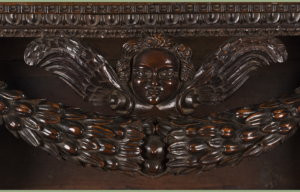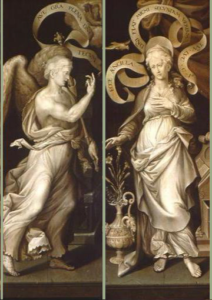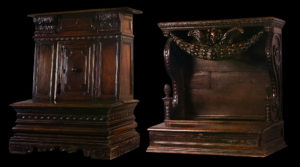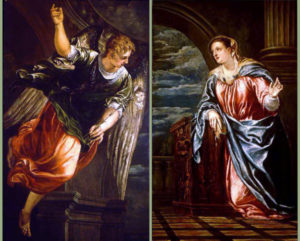Object of the Month: September 2021
Prie Dieux
Walnut
16th century, Italian
When one thinks of prayer, furniture is not usually the first thing to come to mind. In Matthew 6:5-6, Christ encouraged making requests in prayer privately, rather than praying to be noticed publicly. However, a common piece of furniture constructed for the purpose of prayer was manufactured during the Renaissance and is still being made today. It is known as a prie-dieu, derived from French for “praying to God.” This special furnishing serves the same purpose as a prayer desk and a prayer chair.
M&G currently has two prie-dieux in its collection. These may have been used in a church, cathedral, or even a home. As a common piece of liturgical furniture in the Roman Catholic Church, they are still in use for worship, weddings, and funerals. When President Kennedy was lying in state, prie-dieux were in the same room.
 Both of M&G’s Prie Dieux are from Italy, dating to the early Renaissance in the late 15th to mid-16th centuries. Ornately carved walnut adds to the richness of their finish. One has a hinged kneeler with a raised panel door in the middle and a small drawer at the top. The other’s “lectern top” sits on “two powerful scroll consoles edged with gouge carving in a scale effect; the base terminates in small posts with pine-cone finials.” However, “the most striking feature is the festoon suspended from the top” with “fruit-and-leaf forms enclosing a winged angel head.”
Both of M&G’s Prie Dieux are from Italy, dating to the early Renaissance in the late 15th to mid-16th centuries. Ornately carved walnut adds to the richness of their finish. One has a hinged kneeler with a raised panel door in the middle and a small drawer at the top. The other’s “lectern top” sits on “two powerful scroll consoles edged with gouge carving in a scale effect; the base terminates in small posts with pine-cone finials.” However, “the most striking feature is the festoon suspended from the top” with “fruit-and-leaf forms enclosing a winged angel head.”
Additionally, two paintings in M&G’s collection include prie-dieux. Both pictures highlight the importance of the Annunciation. The archangel Gabriel came to Mary to inform her that she had found grace in the sight of God. She would be privileged to bear the long-awaited Messiah, Jesus Christ. Christ Himself would become the only means of access to God the Father—through prayer. As explained in I Timothy 2:5-6, this direct access was accomplished through His passion and resurrection, which is symbolized by an open door on the prie-dieu. Fellowship with God in heaven is available to all people.
St. Gabriel the Archangel and The Virgin Annunciate by Venetian Reniassance painter, Francesco Montemezzano, were formerly one complete canvas (with one other M&G painting of God the Father depicted with a group of angels). These works were separated into three sections, which are all in M&G’s collection. The artist depicts Mary kneeling at her prie-dieu as she converses with Gabriel, who is seen on the opposite canvas.
The Altar Wings with Scenes from the Birth of Christ was created by an unknown Netherlandish artist. These wood panel paintings were completed during the same century as the Montemezzano canvases—roughly mid to late 1500s. Once the hinged doors of a larger altarpiece, these special panels hid the interior artistic scenes, which would be opened for special services or events. The interior paintings were in vivid color; however, the exterior doors like these were usually painted in gray tones, known as grisaille. This technique suggested a sculptural effect. Gabriel the archangel is positioned on the left panel facing Mary on the right. Mary is depicted with a lily (symbolic of her purity and Christ’s future resurrection) and a prie-dieu (on the far-right edge).
Prie-dieux are found in museum collections around the world—both as furniture and within the pictorial settings of Old Master paintings. London’s Victoria and Albert Museum has a prie-dieu closely resembling one of M&G’s. The National Gallery’s Venetian Annunciation depicts Mary sitting at a prie-dieu.
Prayer is more often discussed than practiced. Fortunately, the opportunity exists for not only God’s children to approach their Heavenly Father, but anyone seeking His help—with or without a prie-dieu.
John Good, Security Manager
Published 2021
Further Resources:
Aronson, Joseph, Furniture in the Bob Jones University Collection
Hiebert, D. Edmond, Working With God Through Prayer

